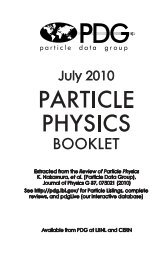30. Passage of particles through matter 1 - Particle Data Group
30. Passage of particles through matter 1 - Particle Data Group
30. Passage of particles through matter 1 - Particle Data Group
Create successful ePaper yourself
Turn your PDF publications into a flip-book with our unique Google optimized e-Paper software.
dE/dx × X 0 (MeV)<br />
200<br />
100<br />
70<br />
50<br />
40<br />
30<br />
20<br />
<strong>30.</strong> <strong>Passage</strong> <strong>of</strong> <strong>particles</strong> <strong>through</strong> <strong>matter</strong> 21<br />
Copper<br />
X 0 = 12.86 g cm −2<br />
E c = 19.63 MeV<br />
Rossi:<br />
Ionization per X 0<br />
= electron energy<br />
Brems ≈ E<br />
Total<br />
Ionization<br />
Exact bremsstrahlung<br />
Brems = ionization<br />
10<br />
2 5 10 20 50 100 200<br />
Electron energy (MeV)<br />
Figure <strong>30.</strong>13: Two definitions <strong>of</strong> the critical energy Ec.<br />
E c (MeV)<br />
400<br />
200<br />
100<br />
50<br />
20<br />
10<br />
5<br />
610 ________ MeV<br />
Z + 1.24<br />
Solids<br />
Gases<br />
710 MeV<br />
________<br />
Z + 0.92<br />
H He Li Be B CNO Ne Fe Sn<br />
1 2 5 10<br />
Z<br />
20 50 100<br />
Figure <strong>30.</strong>14: Electron critical energy for the chemical elements, using<br />
Rossi’s definition [2]. The fits shown are for solids and liquids (solid line)<br />
and gases (dashed line). The rms deviation is 2.2% for the solids and 4.0%<br />
for the gases. (Computed with code supplied by A. Fassó.)<br />
travelling a distance d ≪ X0 is<br />
Nγ = d<br />
�<br />
4<br />
3 ln<br />
� �<br />
kmax<br />
X0<br />
kmin<br />
− 4(kmax − kmin)<br />
3E<br />
June 18, 2012 16:19<br />
+ k2 max − k2 min<br />
2E2 �<br />
. (<strong>30.</strong>29)







